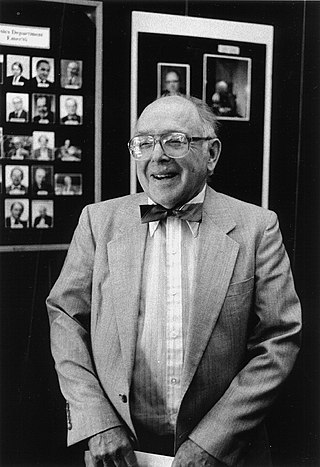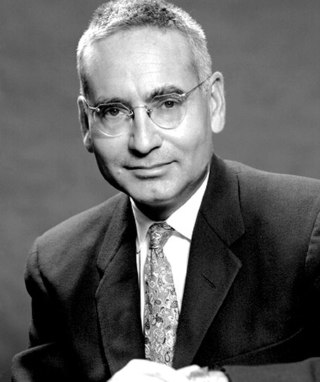Related Research Articles

Oak Ridge National Laboratory (ORNL) is a federally funded research and development center in Oak Ridge, Tennessee, United States. Founded in 1943, the laboratory is now sponsored by the United States Department of Energy and administered by UT–Battelle, LLC.

Oak Ridge is a city in Anderson and Roane counties in the eastern part of the U.S. state of Tennessee, about 25 miles (40 km) west of downtown Knoxville. Oak Ridge's population was 31,402 at the 2020 census. It is part of the Knoxville Metropolitan Area. Oak Ridge's nicknames include the Atomic City, the Secret City, the Ridge, the Town the Atomic Bomb Built, and the City Behind the Fence.

The Federation of American Scientists (FAS) is an American nonprofit global policy think tank with the stated intent of using science and scientific analysis to attempt to make the world more secure. FAS was founded in 1946 by scientists who worked on the Manhattan Project to develop the first atomic bombs. The Federation of American Scientists states that it aims to reduce the amount of nuclear weapons that are in use, and prevent nuclear and radiological terrorism. It says it aims to present high standards for nuclear energy's safety and security, illuminate government secrecy practices, as well as track and eliminate the global illicit trade of conventional, nuclear, biological and chemical weapons. With 100 sponsors, the Federation of American Scientists says that it promotes a safer and more secure world by developing and advancing solutions to important science and technology security policy problems by educating the public and policy makers, and promoting transparency through research and analysis to maximize impact on policy. FAS projects are organized in three main programs: nuclear security, government secrecy, and biosecurity. FAS has played a role in the control of atomic energy and weapons, as well as better international monitoring of atomic activities.

Clifford Glenwood Shull was a Nobel Prize-winning American physicist.

The United States Department of Energy National Laboratories and Technology Centers is a system of laboratories overseen by the United States Department of Energy (DOE) for scientific and technological research. The primary mission of the DOE national laboratories is to conduct research and development (R&D) addressing national priorities: energy and climate, the environment, national security, and health. Sixteen of the seventeen DOE national laboratories are federally funded research and development centers administered, managed, operated and staffed by private-sector organizations under management and operating (M&O) contracts with the DOE.

The Aircraft Nuclear Propulsion (ANP) program and the preceding Nuclear Energy for the Propulsion of Aircraft (NEPA) project worked to develop a nuclear propulsion system for aircraft. The United States Army Air Forces initiated Project NEPA on May 28, 1946. NEPA operated until May 1951, when the project was transferred to the joint Atomic Energy Commission (AEC)/USAF ANP. The USAF pursued two different systems for nuclear-powered jet engines, the Direct Air Cycle concept, which was developed by General Electric, and Indirect Air Cycle, which was assigned to Pratt & Whitney. The program was intended to develop and test the Convair X-6, but was canceled in 1961 before that aircraft was built. The total cost of the program from 1946 to 1961 was about $1 billion.
Oak Ridge Associated Universities (ORAU) is a consortium of American universities headquartered in Oak Ridge, Tennessee, with offices in Arvada, Colorado, Cincinnati, Ohio, and staff at other locations across the country.

Alvin Martin Weinberg was an American nuclear physicist who was the administrator of Oak Ridge National Laboratory (ORNL) during and after the Manhattan Project. He came to Oak Ridge, Tennessee, in 1945 and remained there until his death in 2006. He was the first to use the term "Faustian bargain" to describe nuclear energy.

The Clinch River Nuclear Site (CRNS) is a project site owned by the Tennessee Valley Authority (TVA). It was once proposed as the Clinch River Breeder Reactor Project of the U.S. Atomic Energy Commission and the U.S. electric power industry to design and construct a sodium-cooled fast-neutron nuclear reactor. The project was opposed by President Carter.

Witold (Witek) Nazarewicz is a Polish-American nuclear physicist, researcher, and educator. He is a John A. Hannah Distinguished Professor in Physics and Chief Scientist at the Facility for Rare Isotope Beams (FRIB) and the Department of Physics and Astronomy at Michigan State University, and a Professor at the University of Warsaw, Faculty of Physics, Institute of Theoretical Physics.

Karl Ziegler Morgan, was an American physicist who was one of the founders of the field of radiation health physics. He was director of health physics at Oak Ridge National Laboratory from the time in the Manhattan Project late 1940s until his retirement in 1972.

Ishrat Hussain Usmani NI, best known as I. H. Usmani, was a Pakistani atomic physicist, and later a public official who chaired the Pakistan Atomic Energy Commission (PAEC) from 1960 to 1971 as well as overseeing the establishment of the Space Research Commission.
Alvin W. Trivelpiece was an American physicist whose varied career included positions as director of the Office of Energy Research of the U.S. Department of Energy (DOE), executive officer of the American Association for the Advancement of Science (AAAS), and director of Oak Ridge National Laboratory (ORNL). He was also a professor of physics and a corporate executive. Trivelpiece's research focused on plasma physics, controlled thermonuclear research, and particle accelerators. He received several patents for accelerators and microwave devices. He died in California in 2022 at the age of 91.
Oak Ridge School of Reactor Technology (ORSORT) was the successor of the school known locally as the Clinch College of Nuclear Knowledge, later shorten to Clinch College. ORSORT was authorized and financed by the U.S. government and founded in 1950 by Admiral Hyman G. Rickover and Alvin Weinberg. During its existence, the school was the only educational venue in the U.S. from where a comprehensive twelve-month education and training in either "Reactor Hazards Analysis" or "Reactor Operations" could be obtained, with accompanying certificates. Funding ended and the school was closed in 1965, shortly after authorization was extended to select U.S. universities to develop their own Nuclear Engineering curricula. Housed at the Oak Ridge National Laboratory, this unique venue and its renowned instructors offered its students the highest level of education of practical applications of atomic energy available at the time, and first-hand exposure to a variety of nuclear reactor designs including the legendary first graphite reactor, pool reactor, high temperature gas reactor, molten salt reactor, fast reactor and high flux reactor.
Herman Postma was an American scientist and educational leader. Born in Wilmington, North Carolina, he moved to Oak Ridge, Tennessee, in 1959 after attending Duke, Harvard and MIT. Much of Postma's career was at Oak Ridge National Laboratory where he served as Laboratory Director from 1974 to 1988.
Consortium for the Advanced Simulation of Light Water Reactors (CASL) is an Energy Innovation Hub sponsored by United States Department of Energy (DOE) and based at Oak Ridge National Laboratory (ORNL). CASL combines fundamental research and technology development through an integrated partnership of government, academia, and industry that extends across the nuclear energy enterprise. The goal of CASL is to develop advanced computational models of light water reactors (LWRs) that can be used by utilities, fuel vendors, universities, and national laboratories to help improve the performance of existing and future nuclear reactors. CASL was created in May 2010, and was the first energy innovation hub to be awarded.
Herbert G. MacPherson was an American nuclear engineer and deputy director of Oak Ridge National Laboratory (ORNL). He contributed to the design and development of nuclear reactors and in the opinion of Alvin Weinberg he was "the country's foremost expert on graphite"...

Clarice Evone Phelps (née Salone) is an American nuclear chemist researching the processing of radioactive transuranic elements at the US Department of Energy's Oak Ridge National Laboratory (ORNL). She was part of ORNL's team that collaborated with the Joint Institute for Nuclear Research to discover tennessine. The International Union of Pure and Applied Chemistry (IUPAC) recognizes her as the first African-American woman to be involved with the discovery of a chemical element.

Georgia "Gina" D. Tourassi is the Director of the Oak Ridge National Laboratory health data sciences institute and adjunct Professor of radiology at Duke University. She works on biomedical informatics, computer-aided diagnosis and artificial intelligence (AI) in health care.

David Edward Reichle is an American ecologist who worked at the Oak Ridge National Laboratory (ORNL) and is known for his pioneering research on the movement of radionuclides in the environment and the carbon metabolism of forest ecosystems. From 1967 to 1981 he was co-chair of Woodlands for the International Biological Programme. He served as Director of ORNL’s Environmental Sciences Division (1986-1990) and retired in 2000 as Associate Director of the Oak Ridge National Laboratory. His advanced text, The Global Carbon Cycle and Climate Change: scaling ecological energetics from the organism to the biosphere was published in 2020.
References
- 1 2 Annie Birdsong, Ralph Nader's Childhood Roots Archived 2017-11-07 at the Wayback Machine , Green Party of Ohio
- ↑ United States Department of State (1965). Studies in Progress or Recently Completed: Arms Control and Disarmament. Washington, D.C. p. 22.
- ↑ Claire Nader, The Technical Expert in a Democracy, Bulletin of the Atomic Scientists , May 1966.
- ↑ Charles Barton, Milton Shaw: Part III, The Nuclear Green Revolution (blog), February 21, 2008.
- ↑ Balancing Act Archived 2012-09-25 at the Wayback Machine (part of "The First 50 Years", a history of Oak Ridge National Laboratory), ORNL Review v. 25, numbers 3 and 4, 1992
- ↑ Board of Directors and Emeriti Archived 2009-11-08 at the Wayback Machine , Council for Responsible Genetics website